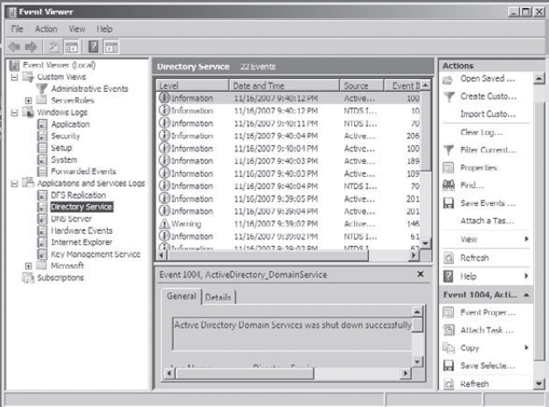Once you have installed and configured
Active Directory, you'll want to verify that you have done so properly.
In the following sections, you'll look at methods for doing this.
1. Using Event Viewer
The first (and perhaps most informative) way to
verify the operations of Active Directory is to query information
stored in the Windows Server 2008 event log. You can do this using the
Windows Server 2008 Event Viewer. Exercise 1 walks you through this procedure. Entries seen with the Event Viewer include errors, warnings, and informational messages.
NOTE
In order to complete the steps in this exercise, you must have configured the local machine as a domain controller.
Open the Event Viewer snap-in from the Administrative Tools program group. In the left pane, under Applications and Services Logs, select Directory Service. In
the right pane, you can sort information by clicking column headings.
For example, you can click the Source column to sort by the service or
process that reported the event.

Double-click
an event in the list to see the details for that item. Note that you
can click the Copy button to copy the event information to the
Clipboard. You can then paste the data into a document for later
reference. Also, you can move between items using the up and down
arrows. Click OK when you are done viewing an event. Filter
an event list by right-clicking the Directory Service item in the left
pane, and selecting the Filter tab. Note that filtering does not remove
entries from the event logs—it only restricts their display. To
verify Active Directory installation, look for events related to the
proper startup of Active Directory, such as Event ID 1000 (Active
Directory Startup Complete) and 1394 (Attempts To Update The Active
Directory Database Are Succeeding). Also, be sure to examine any Error
or Warning messages because these could indicate problems with DNS or
other necessary services. When you're done viewing information in the Event Viewer, close the application.
|
|
Despite its simple user interface and somewhat
limited GUI functionality, the Event Viewer tool can be your best ally
in isolating and troubleshooting problems with Windows Server 2008. The
Event Viewer allows you to view information that is stored in various
log files that are maintained by the operating system. This list of
logs includes the following:
Application Stores messages generated by programs running on
your system. For example, SQL Server 2005 might report the completion
of a database backup job within the Application log.
Security Contains security-related information, as
defined by your auditing settings. For example, you could see when
users have logged onto the system or when particularly sensitive files
have been accessed.
System Contains operating system–related information
and messages. Common messages might include a service startup failure
or information about when the operating system was last rebooted.
Directory service Stores messages and events related to how Active
Directory functions. For example, details related to replication might
be found here.
DNS server Contains details about the operations of the DNS
service. This log is useful for troubleshooting replication or name
resolution problems.
Other log files Contain various features of Windows Server 2008
and the applications that may run on this operating system that can
create additional types of logs. These files allow you to view more
information about other applications or services through the familiar
Event Viewer tool.
Additionally, developers can easily send custom
information from their programs to the Application log. Having all of
this information in one place really makes it easy to analyze operating
system and application messages. Also, many third-party tools and
utilities are available for analyzing log files.
Although the Event Viewer GUI does a reasonably good
job of letting you find the information you need, you might want to
extract information to analyze other systems or applications. One
especially useful feature of the Event Viewer is its ability to save
the log file in various formats. You can access this feature by
clicking Action =>
Save As. You'll be given the option of saving in various formats,
including tab- and comma-delimited text files. You can then open these
files in other applications (such as Microsoft Excel) for additional
data analysis.
Overall, in the real world, the Event Viewer can be
an excellent resource for monitoring and troubleshooting your important
servers and workstations!
|
In addition to providing information about
the status of events related to Active Directory, the Event Viewer
shows you useful information about other system services and
applications. You should routinely use the tool.